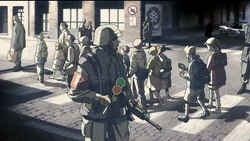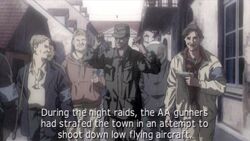San Salvacion is an independent nation located in northwest-central Usea and also the name of its capital, encompassing territory both north and south of the Lambert Mountains. It has been called a "symbol of peace"[1] by other Usean nations and, in modern times, has maintained friendly relations with its neighbors. However, due to its strategic location, San Salvacion has been the site of several major battles throughout its history, most recently in the Continental War and Lighthouse War.
History
Keeper of Stonehenge
After the Ulysses 1994XF04 asteroid was discovered, the leaders of the Usean nations began searching for a location to construct Stonehenge, a railgun system capable of destroying Ulysses. San Salvacion was ultimately chosen as the railgun's site, stemming from its centralized location[2] and reputation as the "symbol of peace" on the Usean continent.[1] Construction of Stonehenge began in the desert region south of the capital, San Salvacion, and continued for several years until its completion in early 1999.[3]
Usean coup d'état
Following the Belkan War, San Salvacion joined other Usean countries in forming a military alliance known as the Usean Allied Forces to match a perceived rising threat of Osean and Yuktobanian influence. Osea extended a military treaty to some southern Usean countries, which some northern and western countries, San Salvacion included, protested against.[4]
On May 30, 1997, the Usean Rebel Forces—a group of conservative extremists—took control of San Salvacion and most other Usean countries to disrupt the treaty's signing. The rebels forced the Usean Allied Forces off the continent in the ensuing coup. Scarface Squadron helped the Allied Forces in pushing the rebels eastward, restoring the sovereignty of San Salvacion and its neighbors.[5]
Ulysses Impact Event
On July 3, 1999, Ulysses entered Earth's atmosphere and shattered into hundreds of pieces, bombarding the northern hemisphere. Although Stonehenge managed to intercept the largest fragments, it was unable to prevent widespread destruction across other parts of the world. Confronted with an unprecedented humanitarian crisis, San Salvacion, like other Usean nations, began accepting a portion of one million refugees displaced by the planetfall.[6]
Hostile takeover
In April 2003, Erusea restricted its issuing of visas to foreign refugees, resulting in the Usean refugee crisis. Harsh sanctions imposed by the Central Usea Treaty Organization (UTO) put pressure on Erusea's unstable economy, and by August, mounting political and economic tensions[6] pressured Erusea's leadership to invade San Salvacion. After intense aerial bombardment and three days of ground combat, the capital fell to Erusean forces and was subsequently occupied.[2] Soon after, Erusea seized control of the STN facility; all of Stonehenge's personnel were taken into Erusean custody.[7]
The international community was outraged: many nations denounced the occupation, claiming that the symbol of peace had been "desecrated" by Erusea's actions. The Federation of Central Usea (FCU) and the UTO called for the immediate withdrawal of all Erusean forces from San Salvacion under threat of military retaliation. The FCU deployed troops around San Salvacion, and a deadline for Erusea's withdrawal was set.[1] In response to Erusea's continued defiance, the FCU and other Usean nations preemptively formed the Independent State Allied Forces (ISAF) to counteract Erusean aggression.[8]
Continental War

Residents of San Salvacion pass an Erusean occupation solider
- "The Allies retreated across the ocean before the onslaught of the enemy. Our little town in the heart of the mainland, fell into deep isolation."
- ― Side Story Narrator[9]
As the Erusean military (reinforced by the overwhelming power of Stonehenge) dealt the ISAF a series of crushing defeats, the country's liberation became increasingly unlikely. For more than a year, San Salvacion was isolated from the events unfurling on the east coast. ISAF broadcasts from North Point were intercepted by Erusean propagandists and eventually ceased to be received. Citizens received rations of food, water and gas and were only allowed access to certain communications technologies, such as crystal radios. As the ISAF retreated before the Erusean onslaught, San Salvacion became a stronghold for the occupation forces: San Profetta Airport served as an Erusean air base, and an unfinished highway was converted into a makeshift runway for the 156th Tactical Fighter Wing "Aquila" (Yellow Squadron), which was assigned to protect Stonehenge.[10]
As the ISAF began to score major victories in the east, a resistance movement, which had formed in the early days of the occupation, began to grow in strength within San Salvacion.[11] On the day of the second assault on Stonehenge, a resistance bomb detonated on Yellow Squadron's runway, destroying the squadron's spare parts and supplies.[12] The squadron scrambled but arrived too late to prevent the STN's destruction.[13] Soon after Stonehenge's destruction, San Salvacion was filled with retreating Erusean troops from the front lines. By summer of 2005, the ISAF began preparations to liberate San Salvacion from Erusean hegemony.[14]
Emancipation
On July 10, 2005, at precisely 12:05 AM Usea Central Time, local resistance fighters ended the standard citywide blackout, and ISAF forces laid siege to the San Salvacion capital. Erusean forces were slowly swept out of each area through intense urban warfare. Amidst the chaos, Andre Wolske, a San Salvacion newscaster, stayed behind and reported live developments throughout the battle.[15]

Resistance fighters hold a captured Erusean soldier at gunpoint
Once the Erusean command realized that San Salvacion was lost, a detachment of six Tu-160 Blackjack bombers was dispatched to raze the city. However, the Erusean aircraft were intercepted by ISAF fighters before they could reach their targets, bringing the battle for San Salvacion's freedom to an end.[15] Many of Erusea's forces, including Yellow Squadron, soon after retreated to help strengthen the Erusean capital's defenses.[16]
In the wake of the city's liberation, the citizens of San Salvacion filled the streets in celebration of the ISAF's return. The remaining Eruseans within the city were rounded up by ISAF forces and the San Salvacion resistance.[16] After the war, San Salvacion likely maintained its friendly relations with the ISAF member states.
Lighthouse War
During the Lighthouse War, San Salvacion was occupied by Erusean forces as they controlled the majority of the Usean continent. On July 16, 2019, the Osean Defense Forces launched Operation Shotgunner in the city of San Salvacion; the operation had an attrition rate of 75%.[17] Following Operation Dragon Breath, San Salvacion, along with several other countries, was liberated by Osean forces.[18]
Gallery
Concept sketch of San Salvacion
Trivia
- "San Salvación" is Spanish for "Saint Salvation".
- Despite Stonehenge being within its borders, most maps of Usea thus far have showed Stonehenge and the city of San Salvacion to be in different countries. This could indicate an unknown change of territory between San Salvacion and its southern neighbor, that Stonehenge is located in an exclave of San Salvacion or may just be a map inconsistency.
- North Point is another Usean nation where the name of the nation and its capital are one and the same.
References
- ↑ 1.0 1.1 1.2 "International Opinion Plummets", War? Retrieved January 30, 2017.
- ↑ 2.0 2.1 World / INVASION!, AC04Web. Published 2001. Retrieved January 30, 2017.
- ↑ "The Titan to Protect the Continent", Our Science: Titan Guns.
- ↑ Intro cutscene, Ace Combat: Assault Horizon Legacy
- ↑ Ace Combat: Assault Horizon Legacy.
- ↑ 6.0 6.1 "Friction Arises from the Refugee Crisis", War? Retrieved January 8, 2017.
- ↑ "Erusea's Aggression", War? Retrieved January 30, 2017.
- ↑ "Nations Unite Against Erusea, ISAF is Founded", War? Retrieved January 31, 2017.
- ↑ Interlude 01, Ace Combat 04: Shattered Skies.
- ↑ Interlude 04, Ace Combat 04: Shattered Skies.
- ↑ Interlude 05, Ace Combat 04: Shattered Skies.
- ↑ Interlude 07, Ace Combat 04: Shattered Skies.
- ↑ Stonehenge Offensive, Ace Combat 04: Shattered Skies.
- ↑ Interlude 09, Ace Combat 04: Shattered Skies.
- ↑ 15.0 15.1 Emancipation, Ace Combat 04: Shattered Skies.
- ↑ 16.0 16.1 Interlude 10, Ace Combat 04: Shattered Skies.
- ↑ SP Mission 03: "Ten Million Relief Plan", Ace Combat 7: Skies Unknown.
- ↑ Mission 12: "Stonehenge Defensive", Ace Combat 7: Skies Unknown.

